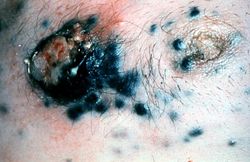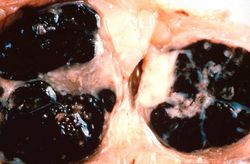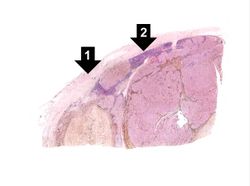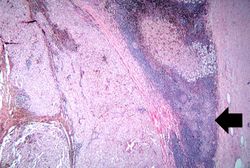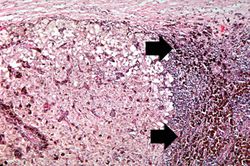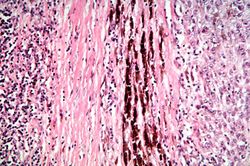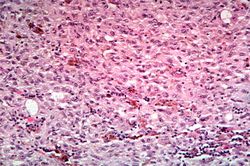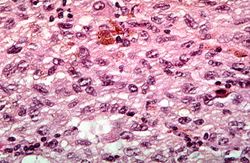Difference between revisions of "IPLab:Lab 7:Malignant Melanoma"
Seung Park (talk | contribs) (→Images) |
Seung Park (talk | contribs) |
||
| Line 13: | Line 13: | ||
File:IPLab7Melanoma8.jpg|This is a high-power photomicrograph of the main tumor mass showing the cellular details. The individual melanoma cells contain large nuclei with irregular contours having chromatin clumped at the periphery of the nuclear membrane and prominent red (eosinophilic) nucleoli. | File:IPLab7Melanoma8.jpg|This is a high-power photomicrograph of the main tumor mass showing the cellular details. The individual melanoma cells contain large nuclei with irregular contours having chromatin clumped at the periphery of the nuclear membrane and prominent red (eosinophilic) nucleoli. | ||
</gallery> | </gallery> | ||
| + | |||
| + | == Virtual Microscopy == | ||
| + | <peir-vm>IPLab7Melanoma</peir-vm> | ||
== Study Question == | == Study Question == | ||
Revision as of 16:25, 3 January 2014
Contents
Clinical Summary[edit]
This 68-year-old white male had a local excision of a pigmented lesion (melanoma) on the skin of his back. Three years later he became aware of a "lump" in his left axilla. Examination confirmed the presence of a 2.3-cm nodular lesion. Subsequently, the patient underwent a surgical procedure for removal of axillary lymph nodes.
Images[edit]
Virtual Microscopy[edit]
Study Question[edit]
Additional Resources[edit]
Reference[edit]
- eMedicine Medical Library: Cutaneous Melanoma
- eMedicine Medical Library: Malignant Melanoma
- eMedicine Medical Library: Skin Cancer -- Melanoma
- Merck Manual: Melanoma
Journal Articles[edit]
- Banerjee SS, Harris M. Morphological and immunophenotypic variations in malignant melanoma. Histopathology 2000 May;36(5):387-402.
Images[edit]
Nodular hyperplasia of the prostate--characterized by large discrete prostatic nodules--is a common disorder in men over 50 years of age. The nodules cause the prostate to be enlarged and to have an increased weight. The human prostate is surrounded by a restrictive capsule. These nodules cause increased pressure within the capsule which leads to constriction of the urethra as it passes through the prostate. Urethral constriction leads to retention of urine.
